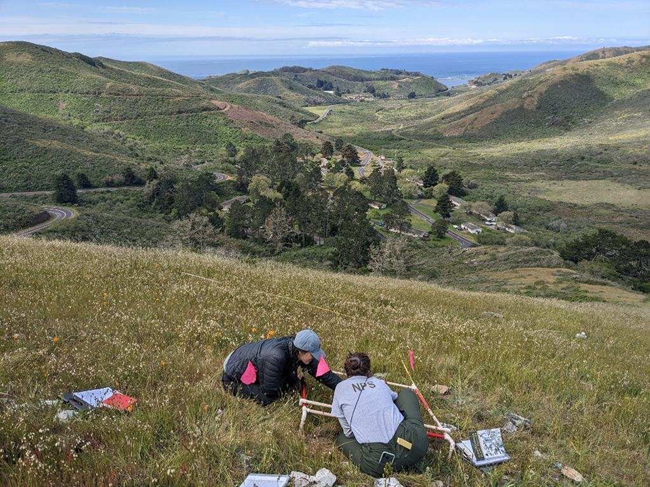Last updated: December 18, 2024
Article
Forging the Future: Investing in Youth and Seed Collection

NPS
Growing the Future
Climate-related disasters, visitor use impacts, and catastrophic fires all pose significant threats to the native grassland flora that compose the ecosystems of many California national parks. Restoring and protecting these native ecosystems is fundamental to the NPS mission of preserving natural resources for current and future generations. However, many parks in California struggle to collect the seeds necessary for the restoration of degraded ecosystems due to a lack of funding and human capacity.
In a project largely funded by BIL, the NPS California Invasive Plant Management Team (CA IMPT) formed an agreement with American Conservation Experience (ACE) to establish developmental opportunities that engaged eight young professionals in seed collection and early detection of invasive plants in parks. Seed collection is the primary task in getting the right seed for use at the right place and the right time per the National Seed Strategy.
The interns supported three seed collection teams across California. In collaboration with the NPS Inventory and Monitoring (I&M) Division, the first team was based at Golden Gate National Recreation Area to support parks in the San Francisco Bay Area Network. This included Golden Gate National Recreation Area, John Muir National Historic Site, Pinnacles National Park, and Point Reyes National Seashore. A second team deployed to the Klamath Network will provide support to Crater Lake National Park, Lava Beds National Monument, Lassen Volcanic National Park, Oregon Caves Monument and Preserve, and Redwood National and State Parks. The third and final team included two positions that exclusively supported the nursery and seed collection program at Sequoia and Kings Canyon National Parks.
Prior to getting out in the field, the eight ACE members worked as a single cohort alongside botanists from I&M and the IPMT to receive botanical trainings. The interns also completed required training modules for the Seeds of Success program, the national seed collection program administered by the Bureau of Land Management (BLM) in cooperation with other federal agencies. The trainings helped the interns develop the skills necessary to meet the goal of establishing at least 50 seed collections across the entire CA IPMT network. These collections totaled over 25,000 seeds each, so park staff have enough supply for nursery growouts and seed amplification, the process of growing plants in agricultural settings outside of parks to support an increase in the volume of seed available for restoration.
In addition to seed collection, the crews located in the San Francisco Bay Area Network and the Klamath Network were cross trained in existing Early Detection and Rapid Response (EDRR) protocols. EDRR is a process botanists use to locate problematic invasive species just as they begin to invade a particular area. After detection, botanists move to quickly contain and remove the new infestation. This concept is fundamental to effective invasive species management, as the earlier an invasive species is detected, the easier and less costly it is to eradicate.
Visualizing the Impacts
This critical investment provides capacity to five parks that would otherwise have little-to-no ongoing seed collection and expanded capacity for existing collection efforts in six other parks for the 2023 and 2024 field seasons. However, there is still a need for infrastructure to support collections, including equipment for seed cleaning, facilities and infrastructure for storage, and additional capacity for more targeted conservation collections. Sustained support for seed collection is vital to ensure reliable availability of genetically appropriate seeds for ecosystem restoration and to foster native plant biodiversity across landscapes in California and Oregon.
Botanists with the CA IMPT expect to restore over 2,500 acres of California grasslands with the seeds collected from this project. The seed collection crews’ work will repair between 100 to 300 acres of habitat critical to the mission blue butterfly, an endangered species endemic to the San Francisco Bay Area. Additionally, seeds collected by the Klamath Network crew will restore lands damaged by recent wildland fires in Whiskeytown National Recreation Area, Crater Lake National Park, Lava Beds National Monument, and Lassen Volcanic National Park. Finally, the seed collection crews will provide the seeds needed to restore crucial riparian areas in Redwood National and State Parks.
This collaborative BIL project promotes the protection and resilience of ecosystems in the future not only by collecting seeds to build a pipeline of plant materials needed for restoration, but also by investing in young botanists who can more broadly contribute to the future of plant conservation in the NPS. The botanical skills the ACE members learn will apply well beyond this project and can help ensure the success of future revegetation efforts. Thanks to BIL funds and support from the CA IMPT, eleven parks are building capacity to rehabilitate and restore impaired ecosystems to preserve these resources into perpetuity.
Tags
- crater lake national park
- golden gate national recreation area
- john muir national historic site
- lassen volcanic national park
- lava beds national monument
- oregon caves national monument & preserve
- pinnacles national park
- point reyes national seashore
- redwood national and state parks
- sequoia & kings canyon national parks
- bipartisan infrastructure law
- ecosystems
- ecosystem restoration
- sfan
- klmn
- edrr
- seed collection
- early detection
- botany
- inflation reduction act
- youth
